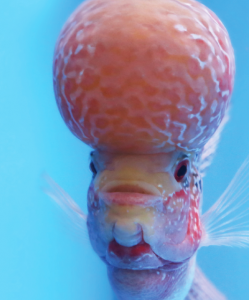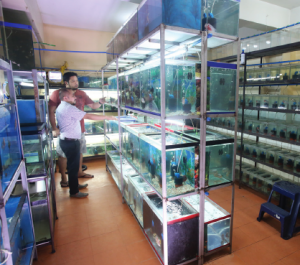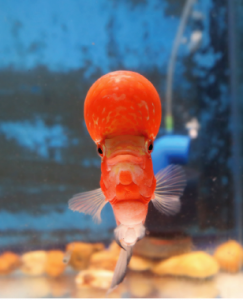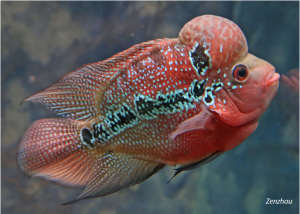The flowerhorn is an interesting paradox: it divides animal fancier opinion with its unusual looks, and as it is a product of human intervention through breeding, it is not a wild-caught species.

Perhaps the best way to appreciate the flowerhorn is to learn more about it from the people who know it best: leading breeders and keepers in the country. While their viewpoints occasionally differ, they offer advice from perspectives both beginners and advanced fishkeepers can benefit from: those of the breeder and the hobbyist.
Can you give us a basic introduction to the flowerhorn, and how it came to be in the Philippines? How big can you expect it to grow, how long is its lifespan, and what other basics should those interested in it know?
(Oliver Firmalino-OF) The flowerhorn is basically the mongrel of fishes. It was first introduced in 1998 by the Malaysians; they originally called the flowerhorn fish “Hua Lou Han.” It was a result of the cross-breeding of different cichlids such as the Red Devil (Citrinellum), also known as ‘human face’; blood parrots from Taiwan; Festae (Amphilophus festae); Midas (Citrinellus); and Trimac (Amphilophus trimaculatus). Although the next generations of flowerhorns were the result of breeding flowerhorns with other flowerhorns.
It took decades before the first variant of flowerhorns were developed. I don’t remember which person first imported it here to the Philippines because a lot of importers are claiming this. But as early as 1998, I think we already have some pendians and goldenbase here. Before, we only have two strains, Pendians (Zenzhou) and Jin Hua. An adult Pendian Strain can grow up to 12- 14 inches; a Jin Hua can reach up to 14-18 inches and lives a lifespan of 16 years!
But now we have several strains like the Zenzhou, Kamfa, KamfaZZ, Goldenbase, and the Silks that grow up to 8’-12’, smaller than the older genes. This is was a result of inbreeding among breeders.
(Tiger Villanueva-TV) The flowerhorn fish originated in Malaysia around 1994 to 1996. I estimate that it was brought here in in the Philippines in limited quantities around year 2000. During the start of the flowerhorn hobby, you could expect the fish to grow up to 16 to 18 inches, but the maximum size is smaller now because of inbreeding and other factors which have greatly reduced its maximum size. At that time (2000 to 2005), its lifespan could reach up to 6 to 7 years.
The basics in keeping them are good, clean water, a good sized tank, good filtration, regular water changes, and good quality fish food.
Here’s some interesting trivia: the flowerhorn fish is a hybrid, meaning it’s a crossbreed from five or more kinds of fishes, mostly cichlids, and was created mostly for feng shui or good luck purposes. (Dr Maoche Nemis, better known as “Bodega Flowerhorn”-BF) Sources: Flowerhorn Craze and the PALHS website.
• 1993: Malaysians admired “Karoi” or warship fish, which had protruding heads; in Taiwan, this fish featured a slightly protruding forehead and a long tail; it was considered to bring good luck.
• 1994: The Red Devil or “human face” and Blood Parrot fish imported from Taiwan to Malaysia are bred. The initial offspring are called the “5 Colors God of Fortune” and quickly became popular.
• 1998: The breed is refined with the importation of the 7 Colors Blue Fiery Mouth (Greenish Gold Tiger) from South America and the Jin Gang Blood Parrot from Taiwan; the offspring are the first generation of flowerhorns, called “Hua Luo Han.”
• The general flowerhorn classification contains several subsets of strains from different countries and breeders. The parent breed is called “Luohan,” from the Chinese word for the Buddhist concept of “arhat.” The four main breeds of flowerhorn are Zhen Zhu or Zenzhou, Golden Monkey, Kamfa, and Goldenbase Faders.
• Prospects: In my opinion, the flowerhorn hobby will definitely be a hobby that will still be existing for years. Considering the number of people engaged in the hobby, almost every province in the Philippines has its own group. and the age groups that are in the hobby are mostly from 15 to 60 years old, so we expect that it will still be existing in the years to come.

What for you are the defining characteristics of the flowerhorn, the thing or things that make them special and/or distinguishes them from other, similar creatures? (TV) The horn or kok (nuchal hump) and vivid colors plus the attitude of the flowerhorn—playful, aggressive—and their fast development makes them special and distinguishes them from other fishes and/or pets.
(OF) Well personally, I admire their face. Beautiful straight markings and different kinds of beautiful colors and the big nuchal hump that they develop; the bigger, the more expensive it is. They are the only fish I had that behave like dogs. They are very responsive and quickly approach the glass every time they see me, unlike other fish that always retreat or snub you when you tap the aquarium glass.
(BF) For me, when I started to keep flowerhorns, I was always fascinated with big kok, worm pearls in the kok, and most especially, the markings like Chinese characters on their bodies. What made you decide to breed the flowerhorn? Was it difficult for you to raise one?
(OF) After joining and organizing various fish shows, it is fulfilling for us hobbyists to breed the best flowerhorn in town and select the best so we can compete and join other fish shows as well. Yes, it is difficult because not all flowerhorn males are fertile and know how to breed and fertilize female eggs. It takes a lot of training and a bit of luck.
What made you decide to keep the flowerhorn? Was it difficult for you to raise one?
(BF) It was 2009 when I started raising flowerhorns. I learned from a friend that they were lucky fish and that they give fortune like arowanas. I placed my first flowerhorn in my clinic. It wasn’t difficult to raise him, but i learned that they need extra care.
(TV) I decided to keep and raise flowerhorns because of their large size when they reach maturity, and ability to improve and grow fast depending on the routine or regimen the owner uses and or practices. One factor that made me keep flowerhorns is because they can be entered in flowerhorn-exclusive competitions/shows, thus making it more challenging to raise and groom so that the fish can look and be at its best when competing against other flowerhorns.
What qualities do you breed for in a flowerhorn and why?
(OF) First, the Nuchal Hump, also known as the ‘kok’; it should be big and a sphere or rounded shape.
Second is the body shape; it should be broad, thick. Third is the mouth; it should have a scissor bite. Fourth, its color should be red like the Marlboro logo or two tone (yellow and red), and pearls should be wormlike, crossing over the kok. Fifth, the fins should be straight, and their tails should be clean, clear, wide, and strong.
Sixth, their markings, also known as “plums,” should be straight and identical on either side of the fish.

What qualities do you look for in a flowerhorn and why?
(TV) Best qualities to look for in flowerhorn fish are (1) formation in the nuchal hump at an early age, which will indicate that the fish will have a large kok when it reaches maturity; (2) Red coloration on all or most parts of the body; (3) Even distribution of “pearls” or the shiny dots around the flowerhorn fish’s body; and (4) An aggressive and playful attitude which indicates that the fish is healthy.
(BF) Personally, I am in love with flowerhorns with big koks, deep red coloration, wormlike pearls in the head, and with strong finnage. These are the qualities every hobbyists wants to have in their flowerhorns.
What are the best things you’ve learned about keeping a flowerhorn, in your experience? What challenges did you face in its care, and how did you overcome these?
(BF) Well, when I started keeping flowerhorns, I became more patient when it came to grooming them. Because there will come a time that you cannot bring out the best in them. But eventually I learned how to take good care of them, and that’s the time I started joining competitions.
I asked some old hobbyists on how to groom them well, and I also researched and read many sites about caring for flowerhorns.
(TV) One of the most important things that I have learned in keeping this kind of fish is patience. Although the flowerhorn does exhibit a faster rate of development as compared to other fish, patience is key in raising these fish as their development is quite different from other tropical fishes.
During the start of the popularity of the flowerhorn, the biggest challenge was acquiring a quality specimen because it was being imported in limited quantities, and also, feeds and meds were hard to find. Due to their being hybrids, they have no natural habitat and their most common diseases were not known yet.
But as years progressed, the industry was able to produce good quality feeds and also medicine that was applicable to their needs.
(OF) It is believed that the flowerhorn brings luck, prosperity, and good fortune to all in the family that keeps it, especially with career, wealth, fame, and even good health. A friend who owned one had a daughter who was in a car accident. She was rushed to the hospital with some minor bruises, but not a single broken bone; when they got home, they found out that very same day, their 2-year-old flowerhorn suddenly died for no reason. They believed that the fish saved her daughter’s life.
The number one challenge in raising flowerhorns is their health; we should be aware of those different common diseases and proper remedies for them. I’ve done a lot of research, and of course, experience is the best teacher.

Do their care requirements vary from other fish? Do they need a lot of attention? Do they need a special diet? What do they eat? Do they require companions? Will they need special item/s in their tanks?
(TV) Care requirements for the flowerhorn do not vary much from other tropical fish, particularly
cichlids. As with keeping other fish, regular water changes should be observed. They should be given enough space to swim around. A diet complete in nutrition is needed for good overall development; it should include good quality pellets as maintenance food and also live feeding, which means food besides pellets, like frozen bloodworms, market shrimp, and beef or chicken heart.
(OF) Basically they are very similar to other known cichlids but the big difference is their being territorial and super-aggressive behavior. I see them very happy when they have an aquarium all to themselves. I keep 20 pieces of 75 gallon aquarium tanks and a lot of small tanks for my growout breed. We call it multiple tank syndrome! (laughs)
Food is a necessity; they need food with higher protein content (for kok development), higher astaxanthin (for color enhancement), and other food additives. Like dogs, we also give them treats once a week, such as market prawns, tubiflex worms, bloodworms or superworms. We prefer to have a bare tank with a blue background so it will be easy for us to clean the bottom of the tank. Some of us put pebbles and crushed corals in there so they can play with it.
(BF) They don’t require as much special treatment apart from normal flowerhorn husbandry, which is good water parameter and food with high protein content.
What are the characteristics of a healthy flowerhorn? Conversely, what signs should keepers look out for that indicate when it is sick? What are its common health problems that keepers should watch out for?
(TV) A healthy flowerhorn would be active, aggressive, and have a good, hearty appetite. Its color should be intense and its kok should be at its best/largest. Signs that the specimen is sick or stressed would be for it to exhibit pale or dark colors, and a smaller than usual nuchal hump. An inactive fish—meaning, it does not swim around in the aquarium but rather stays in one corner or stays put at the bottom of the tank—is not a good sign. A larger than usual belly may indicate that the fish is having digestion problems.
(BF) Basically, a healthy flowerhorn should be active and exhibit good coloration and good deportment. It does not have a big belly, and has a good appetite. Flowerhorns’ common health problems appear during cold weather, because their immune system is decreased during this time, so feeding them too much will greatly affect their digestion.
(OF) They are usually aggressive and very responsive to us humans. Meaning, if the fish stays in one corner, then something is wrong. You should do something about it; examine the fish and determine what symptoms it is showing. Some of the most common diseases are ich (white spot), hexamitiasis (also known as the “head disease” because it manifests as lesions on the head), pimples, dropsy, fin rot, mouth fungal infection, and swimbladder disease.
Is it true that the flowerhorn’s “kok” or nuchthal hump is very vulnerable and delicate? How should it be cared for?
(OF) Yes, since it’s made of fats and soft tissues. Maintaining kok size means keeping an eye on what water parameters you maintain in your tank. Honestly, this is the most challenging part of our hobby. There are two strains of flowerhorns that require two different kinds of water parameters. The zenzhou strains like new water with low nitrate content.
Another one is the Kamfa Strain, which is very fond of old, aged water. The nuchal hump grows bigger when water is dirty; ironic, right? That’s why some hobbyists like the colourful kamfa because they lack time to change water.
(BF) The flowerhorn’s kok should always be handled with care, especially when you are changing the water of your aquarium. You should always be extra careful when playing with your flowerhorns.
(TV) The nuchal hump or kok is not as a vulnerable or delicate as some would think. The care of the kok would fall under care of the fish itself. If the flowerhorn is healthy, then the nuchal hump will be okay too. It is also a good benchmark if the fish is suffering from any ailments or is stressed because if the fish is not in 100% good condition or is stressed, the kok will not be as big or can be seen getting smaller.

Are there misconceptions about flowerhorns that you would like to correct among those who have heard of it but who do not know it well?
(TV) One of the most common misconceptions among people new to this hobby is that the flowerhorn is expensive, but there are a lot of local breeders now who put out quality flowerhorns at very affordable prices. The quality of fish that local breeders produce are comparable to imported ones.
(OF) One of the most common misconceptions is about nuchal hump or kok development. Some people believe that if the parents have huge koks, it is a guarantee that all offspring they produce will inherit it. But the truth is, only 30-40% of its offspring will develop a nuchal hump after grooming. Part of the 60-70% is either cull or female.
5-10% of the 30% will be considered as pick of the litter or can be considered as “Show Grade” or AAA. (This statement is based on a high grade breeding pair with complete features.) This is the big reason why there is a big price difference between fry and show grade juvenile size. It’s the same reason as with dogs; show grade animals are very expensive compared to the average one.
Another common misconception is about gender. They believe that flowerhorns with black spots on its dorsal fin are automatically female. Yes, it’s true like 10 years ago but now, as soon as it reaches 3”-4” you can already check the gender via ventral sexing. It can be considered as female even without the black spotting on dorsal fins.
For someone who is interested in keeping a flowerhorn for a pet, can you give them things to consider before taking the plunge? Who would they make ideal pets for? Or are they better suited to aficionados who want to study them?
(BF) I would advise that you have to be really prepared when you decide to keep a flowerhorn, because it’s really addictive. You won’t be contented with just one flowerhorn; everytime you see a better one, you will always want to have one.
(TV) Things to consider before buying a flowerhorn: Flowerhorns are very territorial and can only be kept alone in one aquarium. This limits the fishowner who wants to keep different kinds of tropical fish, so if you would want to keep more than one—which is usually the case—you will be needing multiple aquariums. They make ideal pets even for those not really into tropical fish because they are a hardy and strong species and have a special quality that makes them interact with their keepers.
(OF) Well, ideal tank size should be between 35-50gals. Water filtration with biological filter is also important. Traditional sponge filter is okay but overhead or sump is better. Flowerhorn fish are very sturdy with different types of water parameters; even on high nitrates, they don’t easily give. Ideal temperature should be between 27-29 degrees. Get your tanks ready because collecting different strains is so addicting! The search for the best-looking flowerhorn is always on for us, whether it is a local breed or an import from Thailand.
How much of a commitment does it take to keep a flowerhorn, and what advice would you have for someone who is keeping them for the first time? Were there any mistakes that you made as a beginner that you feel other beginners should learn from?
(OF) It actually doesn’t require solid commitment. Twenty percent water change once or twice a week is fine. Food is not a problem because there’s a variety of pellets available in any pet shop near you. In every hobby it is important that you do your homework first; research is a must before buying one. Committing mistakes is okay, as long as you learn from them. I suggest that if you have the budget, go buy a juvenile to small size one with visible kok and complete features. But if this is not the case and you are on a tight budget, then gambling with 1” fry is quite exciting yet fulfilling.
(BF) When I began keeping flowerhorns, I always considered my budget. I made sure I don’t spend too much on one flowerhorn, but in the process, I bought so many cheap flowerhorns already and was still not contented with all of them because I was still looking for a better one—not realizing that if I added all those expenses up, I could have bought 2-3 expensive but show grade flowerhorns already! And suddenly, I learned that I had already acquired the so-called “Multiple Tank Syndrome.” Almost all of the corners of our house had aquariums already…including our bathroom!
The Flowerhorn Impact
Learning about as many sides of an issue is key to a community of responsible hobbyists, fanciers, and breeders.
To this end, Animal Scene posed this question to our experts:
“Can you comment on the criticism by cichlid enthusiasts and environmentalists that the flowerhorn
hobby has resulted in the dumping of culled, surplus, and deformed fish into the wild in Malaysia and Singapore, where they became an invasive species?”
OLIVER: It depends on the culture of the country. In our case here in the Philippines, culls, rejects, and unwanted fish of local breeders are sold for a few bucks in small pet shops all around the metro and most especially in Cartimar Pasay—and surprisingly, these sell well. Some of us use them as feeders for other, bigger fish. Wala naman po masama gawin (there’s nothing wrong with making them) feeders, like goldfish, whose cull are sold as feeders for about PhP1 each, depending on size. What I’m trying to say is, there’s still profit in culls and rejects. I feed my culls to my big arowana and barracudas, so I save on costs as well. So it never entered our minds to throw the culls and rejects away in rivers because the truth is, with all the dirty rivers we have, they won’t survive there.
TIGER: While it is true that the flowerhorn is aggressive, easy to breed, and adaptable—and that sadly, they have become an invasive species in the local rivers of Malaysia and Singapore—it is not the only fish that is causing this problem. The Oscar and Snakehead have been causing the same invasive problems in Florida rivers and swamps, and even here in the Philippines, the pleco or janitor fish and the knifefish have become a persistent threat to the natural habitats where they have been accidentally introduced.
I believe that misguided breeders/hobbyists were at fault on this issue. Misguided, because they are not aware of the large size the flowerhorn can reach and surprised and overwhelmed at the number of offspring each batch of breeding pairs produce. As responsible fishkeepers, our answer or solution to this problem is the wide information campaign we are conducting in our shows and competitions and other forums detailing the proper way of disposing of cull fish and advising the misguided fish owners to please not dispose of their large flowerhorns in our rivers and lakes as they will cause environmental damage. Rather, have them adopted by or donated to people who have larger facilities and can care for them properly.
DR. MAU: Due to the fact that flowerhorns can breed easily, a lot of hobbyists and breeders always attempt to crossbreed them. From what I have observed, even those who are just new to the hobby try to breed flowerhorns. They have different reasons for why they do it. This resulted in the overproduction of unwanted and deformed fish. Some of these are being fed to larger fish; others are being dumped in rivers.
Not all hobbyists are to be blamed for what is happening, I think what we need now is to educate all those who are just starting to keep flowerhorns. This will surely benefit all.
With editing by Charlene Bobis
Photos by Jefferey C. Lim
This appeared in Animal Scene’s May 2016 issue.






